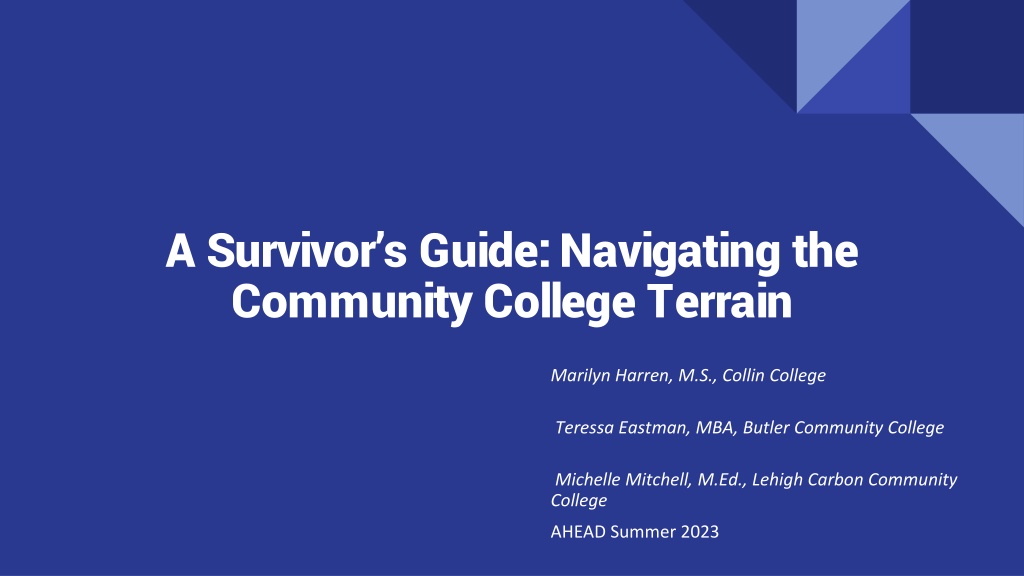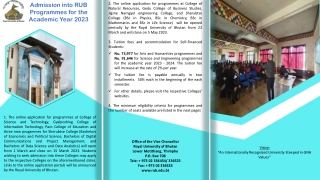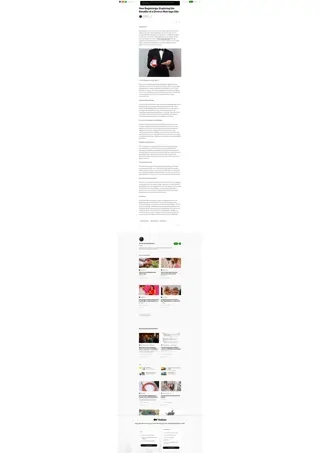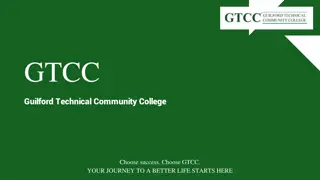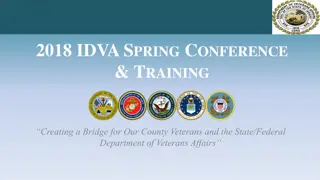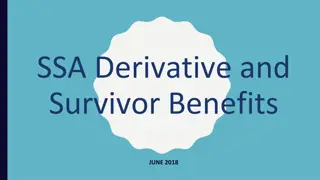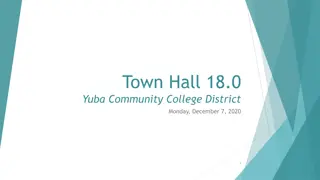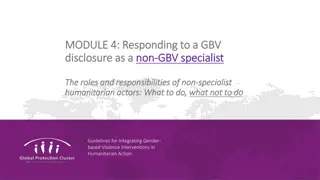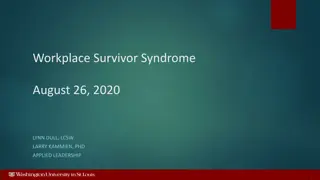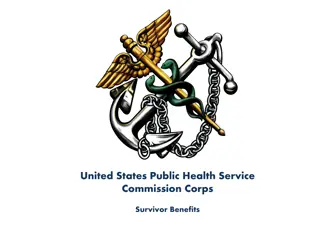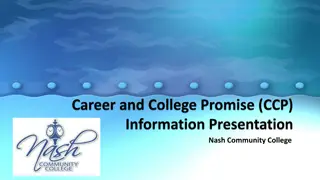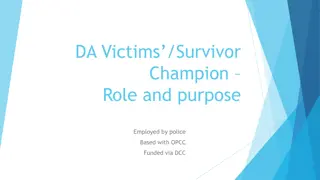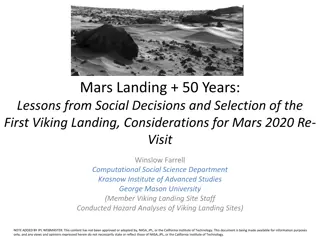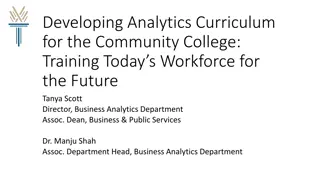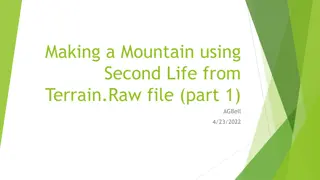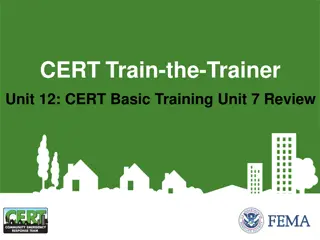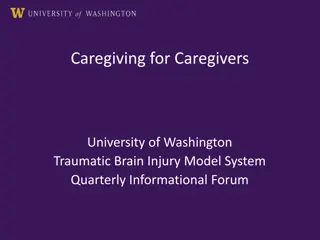Navigating the Community College Terrain: A Survivor's Guide
This guide provides valuable insights and activities for navigating the unique landscape of community colleges, featuring topics like diversity, open enrollment, and building success. Explore engaging activities and discussions to enhance your understanding of community college dynamics.
Download Presentation

Please find below an Image/Link to download the presentation.
The content on the website is provided AS IS for your information and personal use only. It may not be sold, licensed, or shared on other websites without obtaining consent from the author. Download presentation by click this link. If you encounter any issues during the download, it is possible that the publisher has removed the file from their server.
E N D
Presentation Transcript
A Survivors Guide: Navigating the Community College Terrain Marilyn Harren, M.S., Collin College Teressa Eastman, MBA, Butler Community College Michelle Mitchell, M.Ed., Lehigh Carbon Community College AHEAD Summer 2023
Today were going to play some In or Out or Yes/No Based upon the question, decide whether you are a Yes or No Getting to Know You
Getting to Know You (slide #2) I have visited more than five other countries. I have ridden on a motorcycle. I have been to New York City. I have driven a riding lawn mower. I speak multiple languages. I usually eat lunch at my desk. I supervise staff. I like working in an office. I have been a sales person. I have locked myself out of the house.
Agenda for The Day (2:00-5:30) 2:00 2:30 Introductions; Review of Schedule; Unique Characteristics 2:30- Evaluating Your Office/Faculty Training/Perkins 3:30-Break 4:00-5:00 Transitioning & Concurrent/Dual Enrollment 5:00-5:30 Questions
Diversity Sexuality
Unique Qualities #1 Underprepared Demands of the Community school districts government officials Happenings in your state / campus Trainings Time Constraints
Unique Qualities #2 Underprepared Open Enrollment
More conversation about this? Partnerships Technical Standards K&P Meeting
When we say Open Enrollment, what comes to mind?
Activity: Open Enrollment Scenarios
Success Engagement Education Determination Planting the Seed of Success
What is SEED? What is SEED Program Video
Prepare individuals in our community to enter workforce Community is our name Trained Productive Fulfilled
Never losing sight of inclusion and person centered choice
Soft & Person Centered Planning Technical Skills Postsecondary & Vocational Success Social Engagement Mentoring
Support & Programming Overview Vocational Goals Monitoring and vocational experience Socialization 1-3 events per month or 4-10 hours per week Structured Study Lounge 1 hour for every class taken, approx 3-6 hours per week Coaching At least 1 meeting per week Academic Support 1-3 events per month & professor meetings Individualized Instruction 1-5 hours per week
Touch points? Number of students? Staff to student ratios? Student survey responses What else? What do you measure and how do you evaluate your office?
Why do we measure these data points? Expense to College Revenue to College
Non-quantifiable Metrics Time spent with students families in referrals to outside agencies. Time spent with students that choose not to enroll. Understanding non-quantifiable data aids in how much weight to give metrics.
Suggestion to measure Begin to present data in a way to speak the language that Administration might not realize.
Data that could help-Fall 2022 Fall 2021 Completion Data Number of Unduplicated Students Hours Attempted Hours Completed Percent Completion Average GPA 1,664 14,285 10,519 73.6 2.58 ACCESS Students 35,533 286,610 223,042 77.8 2.53 General Ed Students
Data that could help-Spring 2023 Spring 2022 Completion Data Number of Unduplicated Students Hours Attempted Hours Completed Percent Completion Average GPA 1,528 13,207 9,984 75.6 2.72 ACCESS Students 32,842 268,455 211,397 78.7 2.68 General Ed Students
Data Point: Student Surveys #1 Turn this requirement to be more focused on the student and not the office.
Data Point: Student Surveys #2 Getting information about our customers/clients/students can be tough since sometimes the students do not get what they want. Jane Jarrow notes that our actual customer is the institution.
Data Point: Student Surveys #3 Do you feel that you have been treated with respect when working with the DSO office? Which services have you used this semester from the DSO office? (check all that apply) I feel comfortable contacting my DSO Advisor with questions or concerns. My DSO advisor communicates effectively with me.
Data Point: Student Surveys #4 I understand the DSO process and I know what to do each semester to ensure my accommodations are in place. How often do you contact your DSO Advisor? What type of assistive technology this semester, if any, did you use? Do you have any general feedback for the DSO office that can help us to improve services to you?
Faculty Surveys at Lehigh-Carbon CC Survey questions for faculty (Agree, Disagree, N/A) I feel comfortable teaching and working with students with disabilities. I feel that the accommodations recommended by DSO are reasonable and appropriate. Based on my experience, the DSO staff are available to assist with meeting the needs of students with disabilities.
Faculty Surveys at LCCC (2) Based on my experience, the DSO staff are available to assist with meeting the needs of students with disabilities. I understand my responsibilities under the Americans with Disabilities Act and Amendments Act of 2008. Have you visited the DSO web site? (Give site location)
Faculty Surveys at LCCC (3) If you have visited the DSO web site, what did you like? How can the DSO website be improved? Would you attend DSO workshops for further information? Which of the following topics interest you?
Faculty Surveys at LCCC (4) Disability 101 the basics Universal design Accommodation strategies Effective communications with students with disabilities Other:______________________ Comments:
Faculty Development/Training Google Drive Resources
Individuals with disabilities. Individuals from economic disadvantaged families (including low income youth and adults). Individuals preparing for non-traditional fields. Single parents including single pregnant women. Perkins Grant Special Populations Defined
Individuals out of the workforce. English as a second language learners. Individuals experiencing homelessness. Youth who are in or who have aged out of foster care. Youth who have a parent who is a member of the armed forces and is on active duty. Perkins Grant, cont. Special Populations Defined
Ways to utilize Perkins Grant funding Adaptive Equipment Examples Talking scale Enlarged print kitchen equipment Amplified stethoscopes Staff Examples Alternate Format Coordinator Disability Advisor for CTE student population
IEP Meetings Get yourself on the invite list early. Zoom is your friend! Great time to discuss accommodation differences between high school and college. Good time to suggest weaning from the hand holding. Networking time!
Transition Fairs Partner with your Admissions Department. Network with community partners who work with the disabled population. Volunteer for a breakout session.
Community Partnerships Envision Camp Non-profit for improving quality of life for blind and visually impaired individuals. Students experience college life through residence halls. Academic and team building activities. DS provided braille maps of campus for independent navigation.
Navigating High School Student Populations A Guide to Smooth Sailing!
Quick Response How is dual credit set up at your institution? What is the process? Who provides accommodations? Do you look at the Memorandum of Understanding (MOU)?
Defining Populations Concurrent Enrollment Dual Enrollment Early College Academy Students
Concurrent vs. Dual Enrollment Dual Enrollment All dual credit students are concurrent, but not all concurrent students are dual credit. Dual Credit a high school student enrolled in a college class that will count for credit at their high school. Dual credit is a term because the high school can decide if a student will get high school credit as well as the college credit they are paying for. Students must enroll in both high school class and college class. Concurrent Enrollment High School student enrolling in college classes Classes may be held at a college campus, high school/community location or online.
Early College Academy (1) College learning experience for Juniors and Seniors. day college & day high school courses Students take 12 or more credit hours and are considered full-time college students. Opportunity to graduate with Associates Degree before high school graduation.
